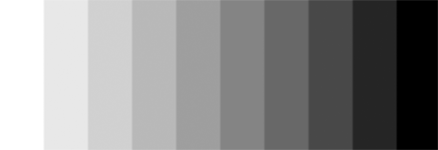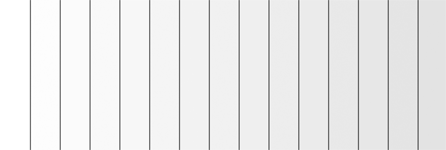Teaching:TUW - UE InfoVis WS 2008/09 - Gruppe 05 - Aufgabe 1 - Mach band: Difference between revisions
No edit summary |
No edit summary |
||
| Line 76: | Line 76: | ||
[Biokurs.de] Lichtsinn. http://www.biokurs.de/skripten/12/bs12-38b.htm | [Biokurs.de] Lichtsinn. http://www.biokurs.de/skripten/12/bs12-38b.htm | ||
[Wikipedia] | [Wikipedia] http://de.wikipedia.org/wiki/Laterale_Hemmung | ||
[Perceptual Stuff] http://perceptualstuff.org/machbandsbasic.html | [Perceptual Stuff] http://perceptualstuff.org/machbandsbasic.html | ||
Revision as of 12:18, 7 November 2008
Mach Band
DEFINITION
light and one dark, separated by a narrow strip with a light-to-dark gradient. The human eye perceives two narrow bands of different brightnesses either side of the gradient that are not present in the original image. The illusion is named after Ernst
Mach.
EXAMPLES
Try to differ as many colors as possible
White to black in 10 Steps
White to grey (255,255,255 -> 200,200,200) in 20 Steps
White to a lighter grey(220) in 20 steps (you can see the difference? – probably)
Same as above but with seperators (Can you see a difference in the middle
part?)
Try it out with different colors http://www.nbb.cornell.edu/neurobio/land/OldStudentProjects/cs490-96to97/anson/MachBandingApplet/
This effect is supposed to be caused by lateral inhibition. Imagine three neighbouring
retina cells - each one of them is stimulated at a different label. The level of the
stimulation is transformed into action potentials and later on forwarded to its
neighbours. Inhibitory interneurons weaken these signals and transfer them to so
called secondary neurons. The attenuation is proportional to the excitation of the
interneurons. By the summation of exciting and alleviative factors to the second
neuron a contrast enhancement is archieved.
We have to examine the edge which is represented schematically between an
homogenous bright area (between receptor 1 and 5) and an homogenous dark area
(between receptor 6 and 10). Without interaction every receptor of 1 to 5 would
represent the same high and every receptor from 6-10 the same low signal. But
because of the connection by an horizontal cell the signal of for example receptor 3 is
attenuated because his neighbours impact on it inhibitorily. Only 5 and 6 are not
affected because the have the same amount of inhibitory and excitatory neighbours.
Machband and Rendering
Due to the linear intensity interpolation the Mach bands can cause trouble when using Gouroud Shading for rendering. Here the Machband effect can be visible at the edges of polygons. A rendering method which can work around the mach-band is Phong Shading.
REFERENCES
[Schmitt, Sturm, Pries, 2006] Lutz Pries, Frank Schmitt, Patrick Sturm. Fragmente eines Skripts zur Bildverarbeitung. 31. Oktober 2006
http://www.uni-koblenz.de/~lb/lehre/ws2006/bv/bvbuch.pdf
[Biokurs.de] Lichtsinn. http://www.biokurs.de/skripten/12/bs12-38b.htm
[Wikipedia] http://de.wikipedia.org/wiki/Laterale_Hemmung
[Perceptual Stuff] http://perceptualstuff.org/machbandsbasic.html
[The Joy of Visual Perception] http://www.yorku.ca/eye/machband.htm
[Mach Banding Interactive Demonstration] http://www.nbb.cornell.edu/neurobio/land/OldStudentProjects/cs490-96to97/anson/MachBandingApplet/



